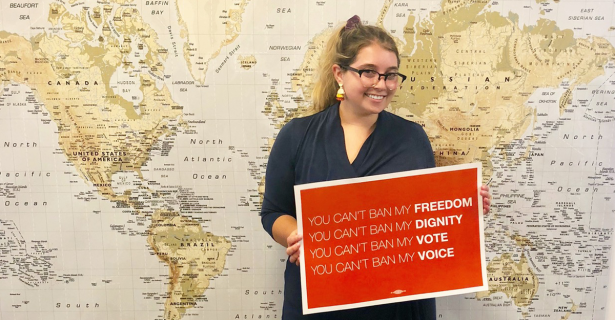This summer, as a result of my IGL-funded internship with the Truman National Security Project, I have the opportunity to live in Washington D.C. On its site, the Project describes itself as “a nationwide membership of diverse leaders inspired to serve in the aftermath of 9/11 and committed to shaping and advocating for tough, smart national security solutions.”
Outside of my internship, I’ve been exploring all that the city has to offer. As the country’s political capital, Washington, D.C. is also the capital of political dissent. A poll from The Washington Post found that 33 percent of all D.C. residents have participated in a protest since the 2016 election - over twice the national average. Spending the summer interning in D.C., I have found myself at many of these protests.
In many circles, including my own, protests are a typical part of one’s weekend or lunch break. The Supreme Court’s Muslim ban decision was released around 10:00am, and by 10:30am I already had a message in my work Slack about an 11:45am protest in front of the court. To fight the family separation policy, my entire office attended the June 30 demonstration together.
My boss regularly encourages me to attend events around town, and with the White House only four blocks away, protests are an easy option. However, with demonstrations nearly every day, it’s hard to not become quickly fatigued from fighting against the policies of the Trump administration - staying constantly angry is exhausting.
At first glance, protests seem straightforward to plan - organizers pick a time and place, make social media pages, and send out mass invites. In fact, my office regularly helps plan protests across the United States. When the Supreme Court approved the Muslim Ban, the Seattle chapter immediately wrote a group letter to the state’s Attorney General and began planning a local protest.
Local D.C. laws require that protests of 25 people or more have a permit. Marching needs approval from the Metropolitan Police, activities near Capitol Hill need the go-ahead from the Capitol Police, demonstrations in the Mall need consent from the U.S. park police, and so on. Given this, the sheer volume of protests should be surprising, but not when you realize that so many local organizations, like my own, are chipping in to help.
Is protesting a productive use of time and outrage, or is it just a performance to make
people feel as if they are useful and on the side of history they want to be on? Polls show that
D.C. protesters are overwhelmingly white, college educated, and in top income brackets. Are those people really using their privilege in the best way? Many of these people could donate money to causes, volunteer their weekends to political campaigns,or utilize their resources in other ways. Even the employees at Truman who organize protests on behalf of Truman and on their own encourage their members to write op-eds or contact their representatives.
From my perspective, people protest because it makes them feel better. Being around other people outraged about that day’s atrocity provides comforting reassurance. More than that though, people feel that protests are useful - they hope that if enough people show up to demonstrate, the administration will change its course or reverse some policy. However, that logic hasn’t proven true in decades, and protests are particularly unlikely to sway a president who is already accustomed to partisan vitriol and pushback. Fighting back against what you see as injustice is always the right thing to do, but attending a protest isn’t the only way to express resistance.

